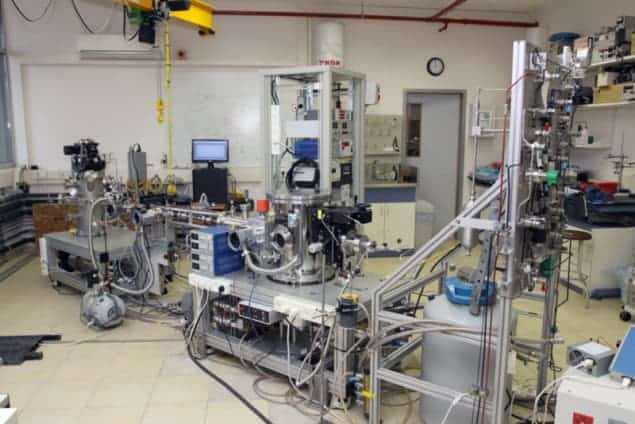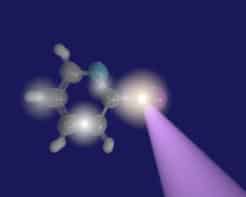
Physicists in Israel have used a modern version of the Stern-Gerlach experiment to separate out water molecules according to the relative spin of their constituent hydrogen atoms. This ability to generate a sample of water with a well-defined nuclear spin could, say the researchers, significantly increase the sensitivity, and hence applicability, of nuclear magnetic resonance (NMR).
Water molecules come in two varieties, or isomers, depending on how the spins of their two hydrogen atoms are oriented relative to one another. When the spins are parallel the molecules are known as “ortho” and when antiparallel they are called “para”. Scientists would like to know more about how the two isomers differ physically and also how they convert from one form to another. To do this, you must first separate the two isomers – something that has proven very difficult.
In 2002 Russian researchers brought water vapour into contact with a substrate and found that ortho-water tended to stick less well to the surface, so leaving the vapour rich in that isomer. However, other groups couldn’t reproduce the experiment, putting the result in doubt. Alternative approaches, such as using strong electric fields or lasers to separate out the isomers, have yet to bear fruit.
Stern-Gerlach revisited
The latest work, carried out by Gil Alexandrowicz and colleagues at the Israel Institute of Technology in Haifa, instead uses the principle exploited by Otto Stern and Walter Gerlach in their pioneering experiment of 1921. Stern and Gerlach were able to separate out a beam of silver atoms into two groups, according to what would come to be understood as the atoms’ spin, or intrinsic angular momentum. To do this they passed the beam through a magnetic field whose strength varied along an axis perpendicular to the beam – being stronger on one side of the beam than the other – meaning that the atoms were forced to one side or the other depending on whether they were spin up or spin down.
This latest experiment is a little more sophisticated, because the spin states of water molecules are slightly more complex than those of silver atoms. The spins of the two hydrogen atoms in each nucleus can combine in four different ways, leading to an ortho “triplet” with total spin 1 and a para “singlet” with total spin 0.
Through a hexapole
To distinguish between these different states, the Israeli group sent a beam of water molecules through a “hexapole” magnetic field, whose gradient, instead of becoming gradually stronger across the beam, goes to zero in the middle of the beam and increases linearly with radius. This arrangement works like a lens, focusing molecules with a total spin of 1 and a “spin projection” of 1 to a point a finite distance from the magnet while leaving the others (those with either a total spin of 1 and a spin projection of 0 or –1 or a total spin of 0) to follow diverging paths.
The team also had to find a way to slow down the beam such that the water molecules had time to be deflected significantly as they passed through the magnet. This the researchers did by mixing 3% water vapour with 97% krypton gas, the heavier krypton atoms having a lower velocity and tending to slow down the beam as a whole. They then placed a 0.5 mm-wide aperture at the expected focus of the beam, about 2 m away from the source, and scanned the aperture across the beam, recording how the water make-up varied as a result. Their measurements showed a focused beam with a diameter of about 1.5 mm, which contained about 97% ortho-water and just 3% para-water.
According to Alexandrowicz, this filtering of water molecules according to their spin could make NMR much more sensitive. NMR uses a powerful magnetic field to align the spins of magnetic nuclei, such as the protons in water, and then exposes these nuclei to radio pulses. Measuring the frequencies at which the nuclei precess around the field direction then provides information on the physical and chemical environment of the nuclei.
Surface NMR possible?
Unfortunately, however, even with a very strong field only a small fraction of the nuclei can be made to initially align, which means that the output signal is weak. So making measurements of a water sample in which almost all of the nuclear spins lie in the same direction would result in a far stronger signal. This, says Alexandrowicz, could expand the use of NMR, allowing it, for example, to be used in surface science – currently, only bulk water contains enough molecules to generate a measurable signal.
Alexandrowicz adds that the spin-selected beam would probably not be applicable to medical magnetic resonance imaging (MRI), because of both the small quantities of ortho-water that it produces and the fact that the spin polarization (isomer separation) is likely to be short-lived. He says that his group will now investigate exactly how long this spin polarization persists in thin layers of water molecules deposited on a surface using the magnetically focused beam, and will then look to carry out ultra-sensitive NMR studies in the near future.
The results are reported in Science 331 319.



